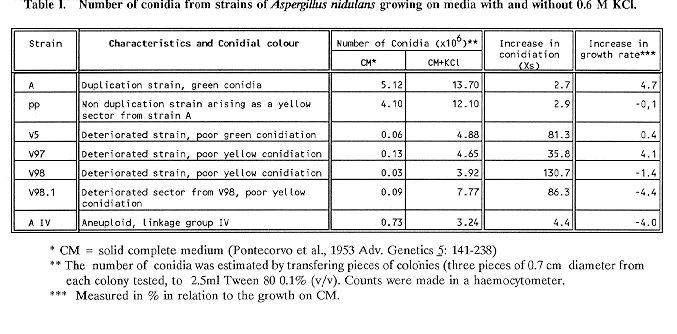Phenotypic reversion of Aspergillus nidulans morphological deteriorated variants in the
presence of osmotic stabilisers
S.M.G. Molina and J.L. Azevedo - Escola Superior de Agricultura "Luiz de Queiroz",
University of Sao Paulo, P.O. Box 9, 13418-900 - Piracicaba, Sao Paulo, Brazil.
Strains of Aspergillus nidulans with chromosome duplications are unstable at mitosis.
They produce sectors which are mainly of two types: improved sectors that result from
partial or total loss of the duplication segment and deteriorated sectors having poor
conidiation and dark brown mycelium. It is postulated that deteriorated variants carry
additional duplications resulting from non-homologous sister-chromatid exchange within the
duplicated segments. (Nga and Roper, 1968 Genetics 58: 193-209). Deteriorated sectors are
unstable but can give more derivatives which probably are the result of transpositions of the
tandem duplication segment to other regions of the genome (Azevedo and Roper, 1970
Genetical Research 16: 79-93). Crosses between these more stable deteriorated variants are
not always successful due probably to incompatibility factors. When protoplast fusion was
attempted to cross some incompatible deteriorated variants, protoplasts were regenerated
on medium with 0.6M KCl as osmotic stabilizer. All colonies on this medium had a normal
phenotype but, when transferred to medium without the osmotic stabilizer, the deteriorated
phenotype returned. It was then supposed that in the presence of the osmotic stabilizer
deteriorated variants are phenocopies of a normal strain. Other osmotic stabilizers were
tested (1M sucrose; 0.5M MgSO4; 1.2M sorbitol) and in all cases normal or almost normal
phenotypes were observed. The original duplication strain that gives rise to deteriorated
variants (strain A), a non diplication strain arising as a sector from strain A, several
deteriorated variants and one aneuploid strain, were tested in relation to the number of
conidia produced on medium with and without 0.6M KCl. Table I shows that all strains
produced more conidia on medium with 0.6M KCl. However, the increased conidiation
observed with deteriorated variants was greater and resulted in colonies with normal or
almost normal phenotypes. Growth rate was not significantly altered on medium with
stabilizer when compared to the growth rate on medium without osmotic stabilizers. Media
containing osmotic stabilizers are being used in our laboratory to distinguish deteriorated
sectors emerging from duplication strains, from other types or sectors with altered
morphology, mainly aneuploids. Deteriorated sectors with characteristic morphology -
brown mycelium and poor conidiation - typically revert to normal morphology on high
osmolarity medium. Other sectors such as color variants and aneuploids do not show
reversion. In meiotic crosses, and mitotic analysis, osmotic stabilizers are also being added
to the medium to make easier conidial color distinction of deteriorated segregants.


